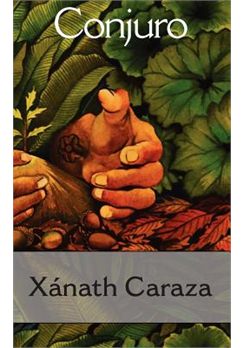Xánath Caraza’s “Conjuro” is a textural salsa of clashing and dazzling cultures, languages, histories and ancestral memories assembled in poems organized as bilingual pairings, mainly in English/Spanish, yet also with embellishments of Nahuatl and other non-European tongues that lend her painting-like compositions a dimension all their own, invoking themes of diaspora, sensuality, the subconscious, nativism, mysticism, mythology, and fantasy.
Caraza is a multicultural hechicera, witch, and I mean that in the best way possible. Originally from Veracruz, Mexico (the gulf port the Spanish used to land and penetrate the fortified mainland en route to today’s current site of Mexico City), and having traveled and taught in places as distant as Spain and China, Caraza is a wise and experienced storyteller that has learned the art of using words and phrases as rich oil paint.
Beginning with a lovely introduction by Fred Arroyo, Caraza’s pieces unveil like past life memories, anchored in the Mexican soul of the Amerindian heartland, while looking back and around, from and at, more distant destinations such as the wounded nuclear reactor in Japan and the legendary Saint Chapelle chapel in Paris. In the opening title piece she seems to prepare herself (and the reader) for what is to follow, as if off to battle evil, tapping into the greatest and most violent fury mankind will ever know:
“Oh brutal strength! Unrelenting strength that resonates and shakes each corner of the Earth…”
Soon follows a sweet tribute to the legendary Nuyorican poetry pioneer Louis Reyes Rivera, who passed away in March of 2012—a poem entitled “Yanga.” Caraza sketches out an African musical rhythm this time, invoking Reyes’ spirit and paying homage to his Afro-Caribbean heritage and all the violence and adversity inherent thereof.
“Este, este es mi poema para Yanga,
Mandinga, malanga, bamba.
Rumba, mambo, samba,
Palabras llegadas de África…”
Other almost cinematic highlights were “Dolphin Men” (Hombres delfín(, “Last Night I Dreamt About the Fog” (Anoche soñé con la niebla), and “Rubies in the Skin” (Rubíes en la piel), but “Conjuro” as a whole will enchant any curious lover of stories richly laden with the haunting imagery that Caraza so expertly arouses…such as in one of the closing pieces, “At the Fountain of the Alcazar of Cordoba” (En el fuente del Alcázar de Córdoba):
“A coin in the fountain
A lost wish
Fleeting hope
In waves of light on water.”




I really liked your article , your article is very petrified me in the learning process and provide additional knowledge to me , maybe I can learn more from you , I will wait for your next article article , thanks
http://yakuza4d.com/peraturan
http://yakuza4d.com
http://yakuza4d.com/home
http://yakuza4d.com/daftar
http://yakuza4d.com/cara_main
http://yakuza4d.com/hasil
http://yakuza4d.com/buku_mimpi
http://beritamedannews.blogspot.com
http://www.cintaberita.com
http://yakuza4d2.com
http://yakuza4d2.com/promo
http://yakuza4d2.com/daftar
http://yakuza4d2.com/cara_main
http://yakuza4d2.com/hasil
http://yakuza4d2.com/buku_mimpi